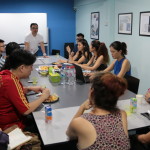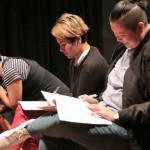On 25 January 2019, our Citizen Reviewer, Jocelyn Chng, attended Q&A (The 36 Questions) by Rachel Erdos and Dancers, which was performed as part of the M1 Singapore Fringe Festival.
While her assignment was to review the work for our Citizens’ Reviews programme, Jocelyn – who is also a dance practitioner – felt so inspired after coming out of the theatre that she requested to create a performative response on top of her written review.
Watch her improvised performance, and find out more about her thoughts on Q&A (The 36 Questions) below.
What was it about Q&A (The 36 Questions) that inspired you to create a movement response?
The idea came to me while I was watching the piece, actually. On a simply visceral level, watching the dancers respond in movement to the various questions made me want to move as well, and that would be my (non-verbal) response to the piece! But I was also recalling recent conversations that I have had about reviewing; thinking in terms of non-conventional review formats, and considering whether a “response” is the same thing as a “review”.
Which of the 36 questions were most thought-provoking for you, and why?
Question #5: “When did you last sing to yourself? To someone else?” seems like a pretty straightforward question, but I realised that I really could not remember, in both cases. I used to enjoy singing very much, and so the realisation that I have not been doing it much in the last few months made me think more about what was going on in my life.
Question #12: “If you could wake up tomorrow having gained one quality or ability, what would it be?” was a fun one, and something that I have often thought about or asked people in the past. The way this question is worded, though, made me consider more nuanced possibilities, because the question is not only about superpowers (which I suppose is a common interpretation), but could be any “quality or ability” within the human realm, such as patience, empathy, intelligence, the ability to code, to ice-skate…
Question #20: “What does friendship mean to you?” was another seemingly simple question, but friendship does mean different things to different people; or rather, there are different kinds of friendship, which different people define differently. Assumptions surrounding definitions of friendship can lead to misunderstandings between people, which is something I have been considering recently as well.
What did you use as the starting point for the choreography for your response?
The idea was for it to be a response to Erdos’ work itself. In the same way that I might respond verbally if someone asked me “What did you think of Q&A?”, I responded in movement. So it was entirely unrehearsed and not choreographed.
You say in your review that “my experience was more of individual reflection and introspection on how I do or do not make connections with people around me in daily life”. What were some of those reflections, and did they influence your approach to your response?
Well, I was mostly reflecting (during and after the piece) on the basic human need for connection, and how despite this need, I find it difficult to make connections with strangers, and indeed actively avoid it most of the time. Even with people I know, but maybe not well, I think there are often missed opportunities to deepen the connections, due to a combination of personality and circumstances. Simply being more aware of this in the past few days has made me consciously try to be nicer to strangers (such as service staff or random people in the lift)!
In terms of influencing my response, I guess on the level of having a certain awareness and mindset, my bodily response might have intuitively reflected that. But I don’t think I was consciously including these reflections as I was responding.
What was it like responding to this piece – which is about connections – as a soloist in your response?
I was indeed thinking about this, and wondered if I should rope in a fellow “responder” or two! But going back to the premise of responding to the piece – rather than being a response to “connections” as an abstract idea, it is a response to the piece as a fellow interlocutor, almost as if I am having a conversation with the piece itself – how I felt about the piece and so on. I wonder if there is any way the creators of the piece might be able to see this and expand the conversation!
Interview by Gwen Pew
Published on 18 February 2019
Q&A (The 36 Questions) by Rachel Erdos and Dancers was performed at Esplanade Theatre Studio from 25 to January 2019.





